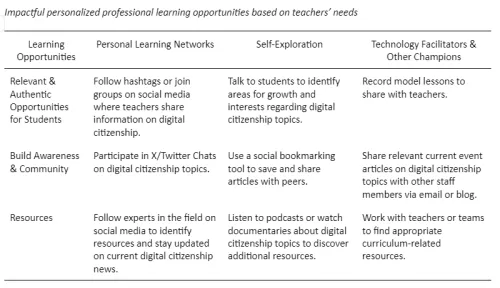Digital citizenship skills are not inherent to educators today. For many teachers, this is because they are uncomfortable with technology themselves. They did not grow up with devices at their fingertips like today’s students have. Even the teachers who grew up with the intricacies of social media were not taught how to be responsible digital citizens and do not know how to teach these lessons to future generations. My interest in this topic came from all of the not-so-smart choices I made as a teenager in the late 90s with AOL Instant Messenger and chat rooms at my fingertips. I shared too much personal information online, not understanding how strangers could use this information. I am very fortunate that nothing happened to me, but we see on the news daily that other children and teens are not that lucky.
Around ten years ago (a few years after entering the educational technology field as a K-5 technology teacher), I learned about Ribble & Park’s Nine Elements of Digital Citizenship, and questions ensued. Why wasn’t I taught about this? Why am I not teaching my students about this? What can we do to protect students and help them thrive online? Since then, I have dedicated much of my professional career to understanding this topic and helping teachers and students understand it. I completed my doctoral dissertation last spring; it focused on ways teachers can integrate digital citizenship into their core content area classes. One of my biggest takeaways from this research is that teachers struggle to integrate digital citizenship into their curriculum because they don’t see themselves as knowledgeable enough to do it well. Great math teachers are great because they see themselves as mathematicians. Great science teachers are scientists. Great literacy teachers are readers and writers. To become a great digital citizenship teacher, educators must see themselves as digital citizens.
I chose to interview teachers with experience teaching digital citizenship lessons to their students so they would have the language to recognize and discuss what they were doing in the classroom. I asked each participant about how they learned what they knew about the topic. Only one could recall an impactful professional development session on digital citizenship. The others shared a myriad of ways they learned about the subject. The most common was through Personal Learning Networks (PLNs), informal groups of educators who communicate and collaborate online for professional development on their own time. Some examples of PLNs shared were groups on social media and communities through professional organizations. Another common way teachers learned about digital citizenship was through their families and having to address issues with their children at home. Several teachers also learned about digital citizenship through their schools' educational technology team and other technology champions. Three teachers I interviewed shared stories about their participation in the digital world. They agreed that learning valuable lessons on their own made them feel more comfortable discussing digital citizenship with their students.
Traditional professional development sessions that we have offered do not meet the needs of our teachers. However, on their own, some educators have found effective ways to learn more about this vital subject. To prepare students for this evolving technological landscape, all teachers need more than these forgettable short-term professional development offerings. As technology leaders, we must find ways to help all of our teachers become digital citizens so that they can prepare our students for their own digital lives. One way to do this is to offer our teachers personalized professional learning opportunities. The US Department of Education’s Office of Educational Technology defines personalized professional learning as “ongoing, job-embedded, and relevant professional learning designed and led by teachers with support from other experts.” The inclusion of teacher agency is crucial and aligned with the findings from my research.
For this work to be impactful, we need to help educators blend what some of them are already doing with support from educational technology teams to ensure that every educator can start to see themselves as digital citizens. Although the findings of parenting and family involvement nor participating in the digital world are particularly applicable to professional learning, we can cultivate some of the other areas teachers identified in our schools. The table below provides several ideas for meeting teachers’ digital citizenship needs with impactful, personalized professional learning experiences.

Although these are just a few ideas for this work, this table shows that technology leaders can address teachers' needs while providing personalized professional learning experiences that align with how they learn. We owe it to our students to help their teachers see themselves as digital citizens so they can pass on their knowledge to help children and teens thrive online.
